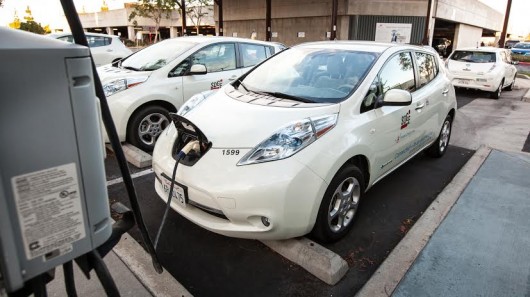Electric cars to become mini power plants in California’s energy grid
March 29, 2015

Like a mini power plant, this electric vehicle can bid on energy in California's wholesale power market
The California utility, San Diego Gas & Electric (SDG&E), has begun bidding energy resources from fleets of electric vehicles and storage systems into the state’s wholesale power market. The pilot program, one of the first of its kind, is meant to provide insights into how electric vehicles and other kinds of distributed energy resources can make the grid more reliable and efficient.
The project is expected to end in late 2015, with the planners hoping to glean valuable information on electric vehicle-grid integration and grid energy distribution. This grid-to-vehicle relationship is seen as a key factor in planning a more distributed energy grid, allowing EVs to charge at night when demand is low and acting as a grid resource when demand is high.
The issue with renewable energy, such as wind and solar, is its reliance on intermittent sources, combined with a lack of robust, efficient storage systems. California’s solar panels produce most of their energy during the middle of the day, but taper off in the evening when consumer energy needs are traditionally highest. Meanwhile, electric car batteries and other energy storage systems typically need recharging on a daily basis, if not more often.
The challenge for utilities such as SDG&E is integrating electric vehicles into the grid and efficiently allocating energy resources to the right place at the cheapest time, while benefiting both the customer and the supplier. The idea is to find workable solutions now, while the market is still relatively small. SDG&E says more than 13,000 electric vehicles are in use in its territory, while the state’s Zero-Emission Vehicles (ZEV) Action Plan wants to put 1.5 million zero-emissions vehicles on the road by 2025. The San Diego utility plans to add at least 5,500 EV charging stations during that time.
For the 10-month project, stationary storage systems and EV charging sites are combined at five locations throughout San Diego County and controlled remotely via software that balances charging needs and grid demand. The software provides "demand response" services; in other words, it charges up EVs during off-peak hours when demand is lower by correlating charging activity with wholesale energy prices, a setup that allows energy to be more efficiently spread to customers throughout the region. The cheaper off-peak charging rates are passed on to EV owners at similar prices to what a conventional power plant would be paid.
"The optimization software polls and understands the current state of charge of the vehicles, and each vehicle’s charging needs over a particular time horizon," SDG&E’s Hanan Eisenman told Gizmag.
As an example, a vehicle might be charged at 45 percent, and need a full charge to be completed sometime in the next four hours. Charging can occur (and be interrupted) at any time, as long as the vehicle is completely charged within the specified period. When the "demand resource" is in the market, instructions are sent by the optimization software to stop charging, which reduces demand in that hour. Charging resumes in lower priced hours, and is completed before the deadline set by the customer.
"Similarly, the storage resources stop charging in these hours, and potentially discharge to ensure the quantity of total response matches what was committed to the CAISO (California Independent System Operators) in our bids,” says Eisenman. "By being a direct participant in the CAISO’s markets and committing to reduce demand in certain high price hours, we allow the CAISO to not commit additional conventional resources in those hours.”
SDG&E is also developing a website/mobile app that lets customers set their EV charging preferences in response to rate signals, effectively acting as their own utility that buys from a larger grid power supplier. It’s also an additional piece of information SDG&E can gather and use on their customers’ charging behavior and grid use.
Source: San Diego Gas & Electric
http://www.gizmag.com/electric-cars-california-power-plants/36779